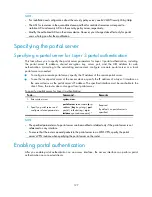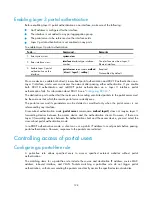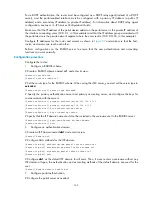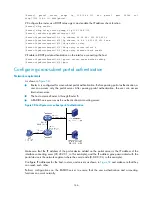
131
Configuring RADIUS related attributes
Specifying NAS-Port-Type for an interface
NAS-Port-Type is a standard RADIUS attribute for indicating a user access port type. With this attribute
specified on an interface, when a portal user logs on from the interface, the router uses the specified
NAS-Port-Type value as that in the RADIUS request to be sent to the RADIUS server. If NAS-Port-Type is
not specified, the router uses the access port type obtained.
If there are multiple network devices between the BAS (the portal authentication access device) and a
portal client, the BAS may not be able to obtain the correct access port information of a user.
To specify the NAS-Port-Type value for an interface:
To do…
Command…
Remarks
1.
Enter system view.
system-view
—
2.
Enter interface view.
interface
interface-type
interface-
number
—
3.
Specify the NAS-Port-Type
value for the interface.
portal nas-port-type
{
ethernet
|
wireless
}
Required
Not configured by default
Specifying a NAS ID profile for an interface
In some networks, users' access points are identified by their access VLANs. Network carriers must use
NAS-identifiers to identify user access points. With a NAS ID profile specified on an interface, when a
user logs in from the interface, the access device checks the specified profile to obtain the NAS ID that is
bound with the access VLAN. The value of this NAS ID is used as that of the NAS-identifier attribute in
the RADIUS packets to be sent to the RADIUS server.
A NAS ID profile defines the binding relationship between VLANs and NAS IDs. A NAS ID-VLAN
binding is defined by
nas-id
id-value
bind vlan
vlan-id
, which is described in detail in the
Security
Command Reference
.
If no NAS-ID profile is specified for an interface or no matching binding is found in the specified profile,
the interface uses the device name as the interface NAS-ID.
To configure a NAS ID profile for an interface:
To do…
Command…
Remarks
1.
Enter system view.
system-view
—
2.
Create a NAS ID profile and
enter NAS ID profile view.
aaa nas-id profile
profile-name
Required.
For more information, see
Security
Command Reference
.
3.
Bind a NAS ID with a VLAN.
nas-id
nas-identifier
bind vlan
vlan-id
Required.
For more information, see
Security
Command Reference
.
4.
Return to system view.
quit
—






























